service CHEVROLET BLAZER 1995 2.G Owners Manual
[x] Cancel search | Manufacturer: CHEVROLET, Model Year: 1995, Model line: BLAZER, Model: CHEVROLET BLAZER 1995 2.GPages: 380, PDF Size: 20.04 MB
Page 3 of 380
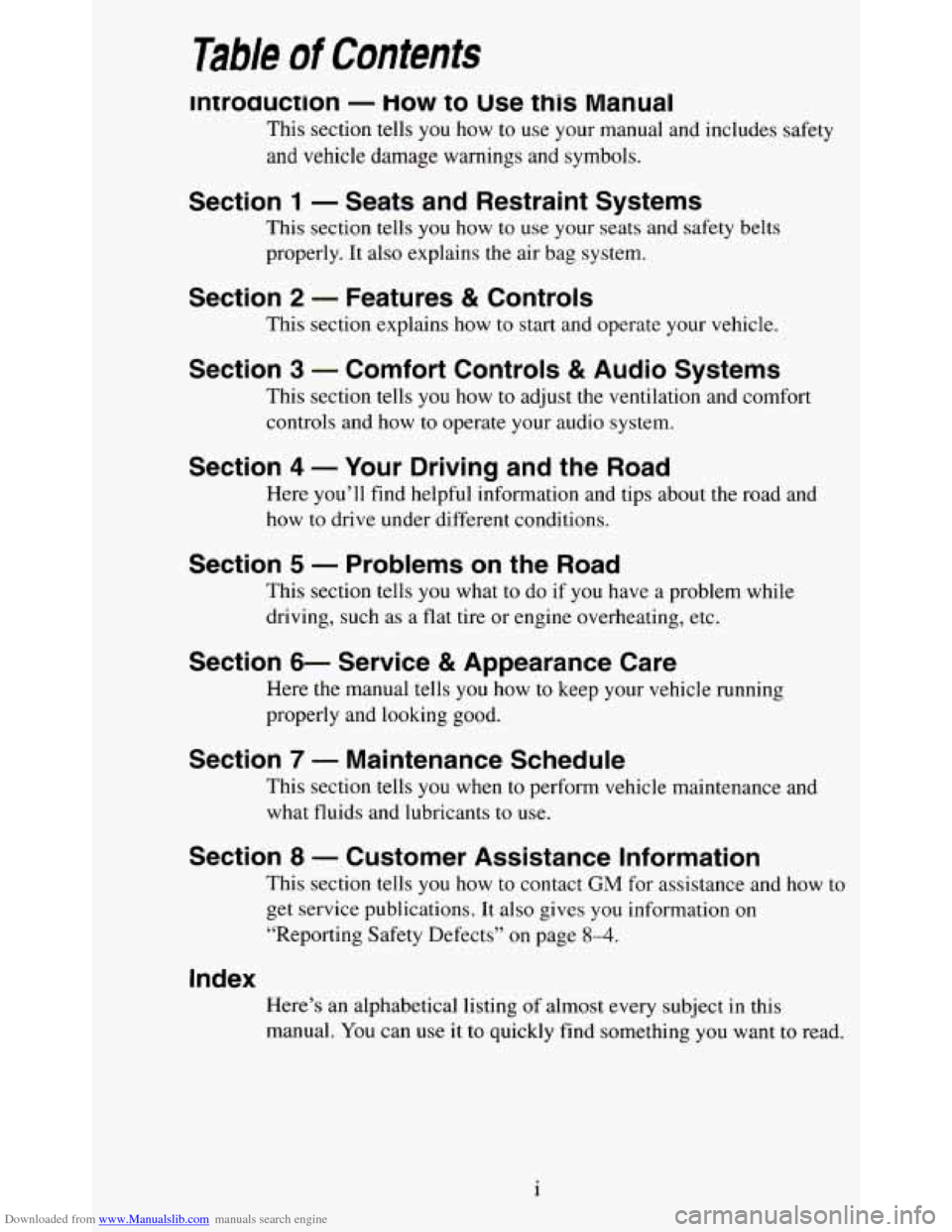
Downloaded from www.Manualslib.com manuals search engine Table of Contents
Inrroauction - How to Use this Manual
This section tells you how to use your manual and includes safety
and vehicle damage warnings and symbols.
Section 1 - Seats and Restraint Systems
This section tells you how to use your seats and safety belts
properly. It also explains the air bag system.
Section 2 - Features & Controls
This section explains how to start and operate your vehicle.
Section 3 - Comfort Controls & Audio Systems
This section tells you how to adjust the ventilation and comfort
controls and how to operate your audio system.
Section 4 - Your Driving and the Road
Here you’ll find helpful information and tips about the road and \
how
to drive under different conditions.
Section 5 - Problems on the Road
This section tells you what to do if you have a problem while
driving, such as a flat tire or engine overheating, etc.
Section 6- Service & Appearance Care
Here the manual tells you how to keep your vehicle running
properly and looking good.
Section 7 - Maintenance Schedule
This section tells you when to perform vehicle maintenance and
what fluids and lubricants to use.
Section 8 - Customer Assistance Information
This section tells you how to contact GM for assistance and how to
get service publications. It also gives you information on
“Reporting Safety Defects” on page
8-4.
Index
Here’s an alphabetical listing of almost every subject in this
manual. You
can use it to quickly find something you want to read.
1
Page 4 of 380
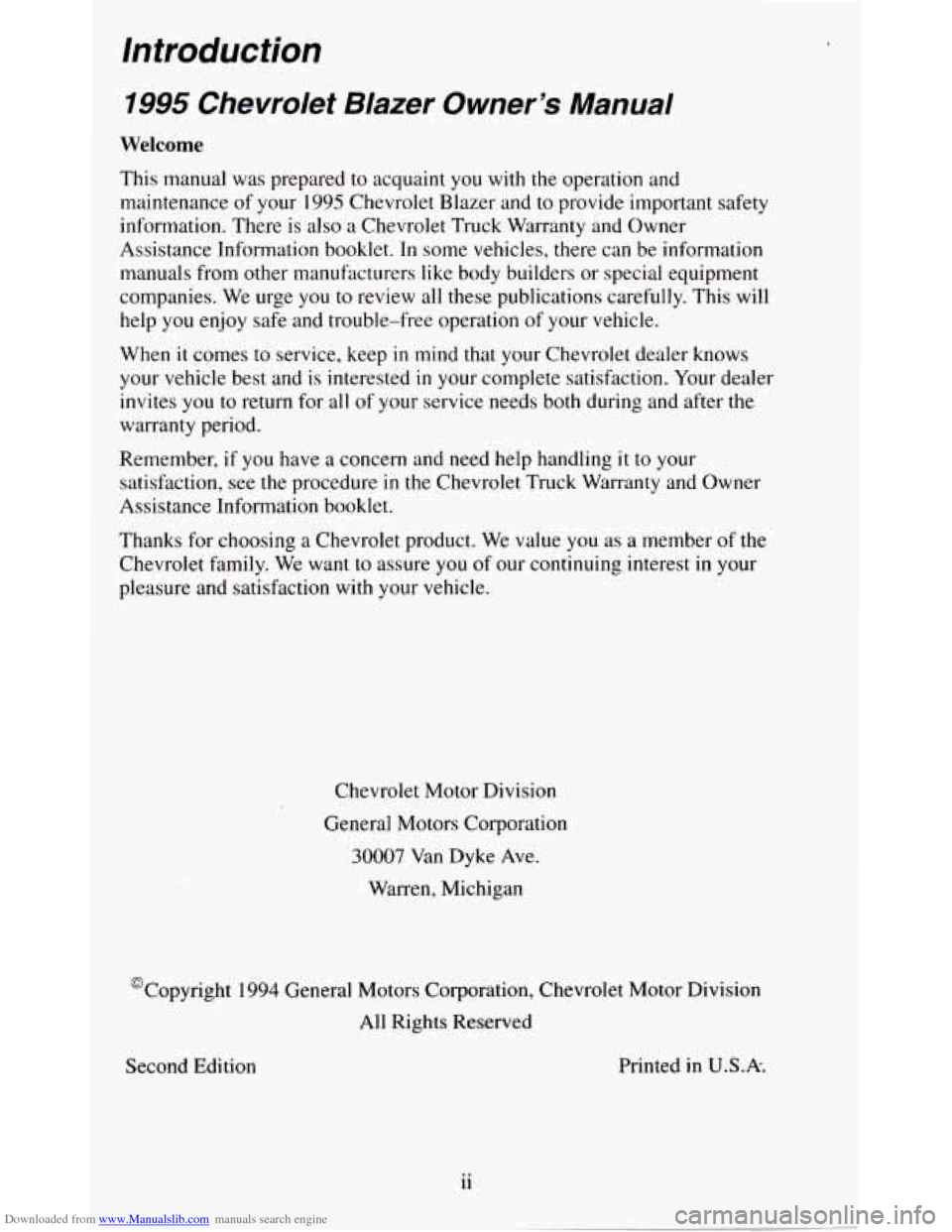
Downloaded from www.Manualslib.com manuals search engine Introduction
1995 Chevrolet Blazer Owner’s Manual
Welcome
This manual was prepared to acquaint you with the operation and
maintenance
of your 1995 Chevrolet Blazer and to provide important safety
information. There is also a Chevrolet Truck Warranty and Owner\
Assistance Information booklet. In some vehicles, there can be \
information manuals from other manufacturers like body builders or special equipment
companies. We urge you to review all these publications carefully. This will
help you enjoy safe and trouble-free operation
of your vehicle.
When
it comes to service, keep in mind that your Chevrolet dealer knows
your vehicle best and is interested in your complete satisfacti\
on. Your dealer
invites you to return for
all of your service needs both during and after the
warranty period.
Remember,
if you have a concern and need help handling it to your
satisfaction, see the procedure
in the Chevrolet Truck Warranty and Owner
Assistance Information booklet.
Thanks for choosing
a Chevrolet product. We value you as a member of the
Chevrolet family. We want
to assure you of our continuing interest in your
pleasure and satisfaction with your vehicle.
Chevrolet Motor Division
General Motors Corporation
30007 Van Dyke Ave.
Warren, Michigan
@Copyright
1994 General Motors Corporation, Chevrolet Motor Division All Rights Reserved
Second Edition Printed in
U.S.A.
.. 11
Page 5 of 380

Downloaded from www.Manualslib.com manuals search engine Important Notes to Owners and Drivers
About This Manual
Please keep this manual in your vehicle so it will be there if you ever need it
when you’re on the road. If you sell the vehicle, please leave this manual in
it
so the new owner can use it.
This manual includes the latest information at the time it
was printed. We
reserve the right to make changes in
the product after that time without
further notice. For vehicles first
sold in Canada, substitute the name
“General Motors of Canada Limited” for Chevrolet Motor Division
whenever it appears in this manual.
About Driving Your Blazer
As with other vehicles of this type, failure to operate this vehicle correctly
may result in loss of control or
an accident. Be sure to read the
“on-pavement” and “off-road” driving guidelines in this manual. (See
“Driving Guidelines” and “Off-Road Driving With your Four-wheel Drive
Vehicle” in the Index.)
WE SUPPORT
VOLUNTARY TECHNICIAN
CERTIFICATION
THROUGH
National Institute for
AUTOMOTIVE
SERVICE
EXCELLENCE
iii
Page 6 of 380
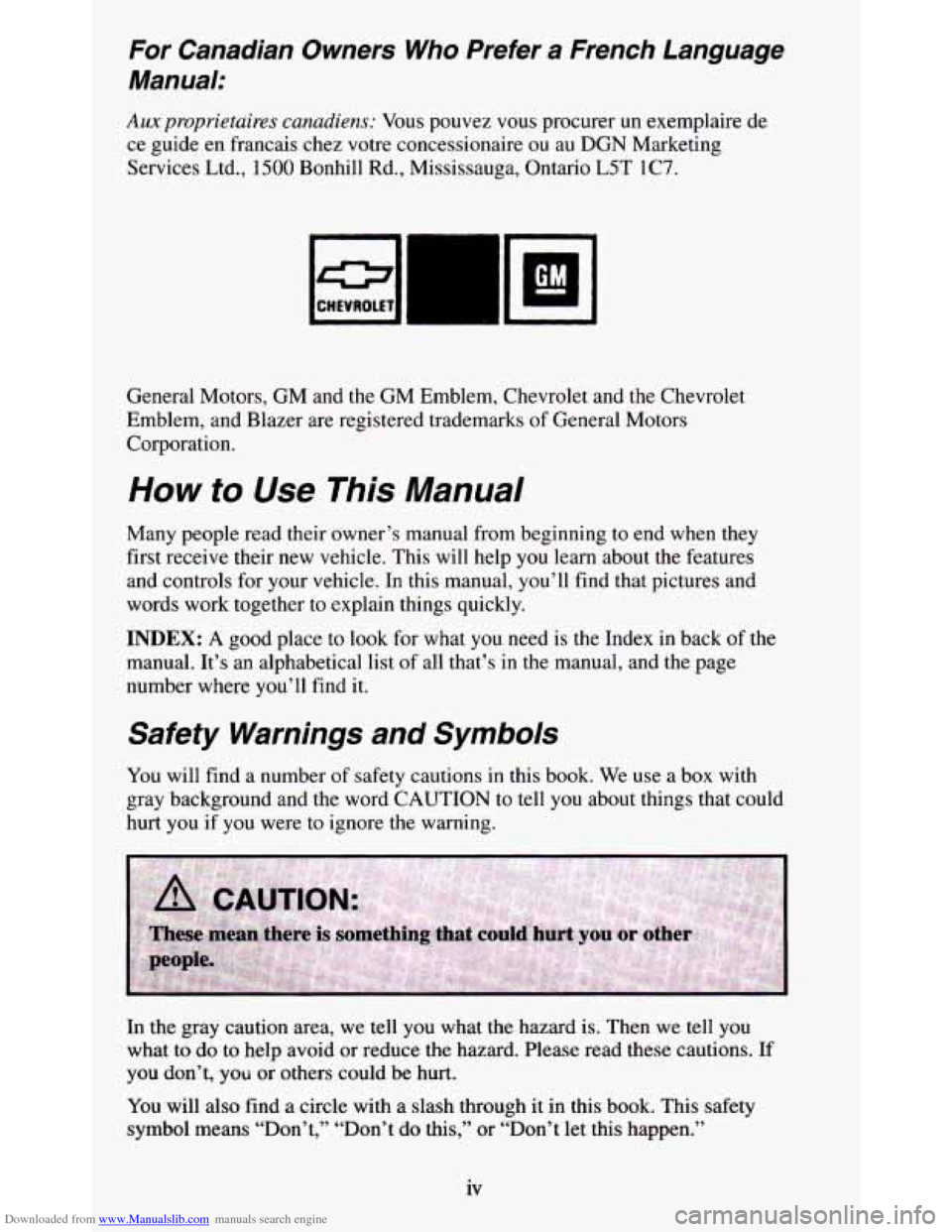
Downloaded from www.Manualslib.com manuals search engine For Canadian Owners Who Prefer a French Language
Manual:
Aux proprietaires canadiens: Vous pouvez vous procurer un exemplaire de
ce guide en francais chez votre concessionaire ou au DGN Marketing
Services Ltd.,
1500 Bonhill Rd., Mississauga, Ontario L5T lC7.
-1-
~0
CHEVROLET
General Motors, GM and the GM Emblem, Chevrolet and the Chevrolet
Emblem, and Blazer are registered trademarks
of General Motors
Corporation.
How to Use This Manual
Many people read their owner’s manual from beginning to end \
when they
first receive their new vehicle. This will help you learn about the features
and controls for your vehicle. In this manual, you’ll find that pictures and
words work together to explain things quickly.
INDEX: A good place to look for what you need is the Index in back of the
manual. It’s an alphabetical list
of all that’s in the manual, and the page
number where you’ll find it.
Safety Warnings and Symbols
You will find a number of safety cautions in this book. We use a box with
gray background and the word CAUTION to tell
you about things that could
hurt you if you were to ignore the warning.
In the gray caution area, we tell you what the hazard is. Then \
we tell you
what to do to help avoid or reduce the hazard. Please read these cautions. If
you don’t,
you or others could be hurt.
You will also find a circle with a slash through it in this book. This safety
symbol means “Don’t,’’ “Don’t do this,’’ or “Don’t let this happen.”
iv
Page 30 of 380
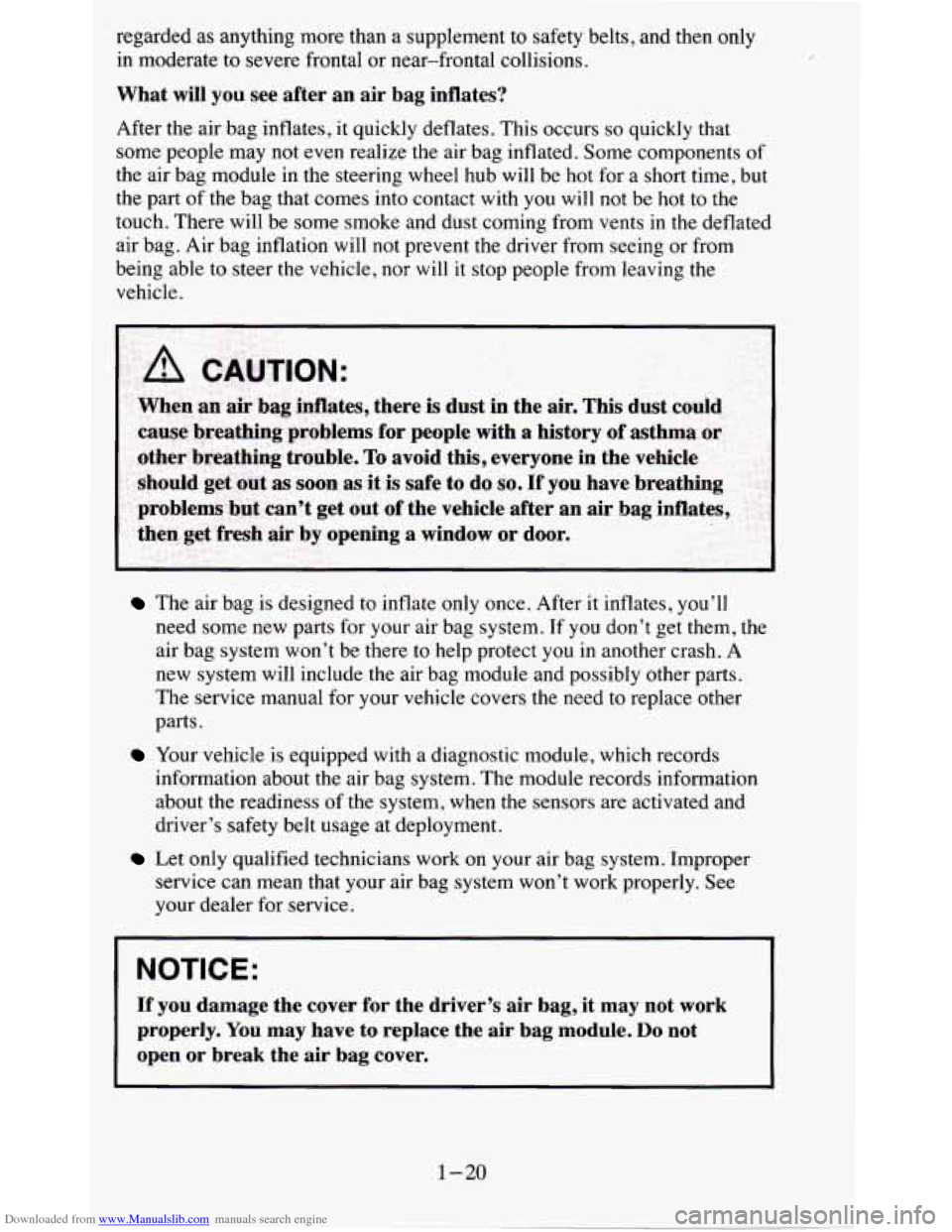
Downloaded from www.Manualslib.com manuals search engine regarded as anything more than a supplement to safety belts, and then only\
in moderate to severe frontal or near-frontal collisions.
What will you see after an air bag inflates?
After the air bag inflates, it quickly deflates. This occurs so quickly that
some people may not even realize the air bag inflated. Some compone\
nts of
the air bag module in the steering wheel hub will be hot for a short\
time, but
the part
of the bag that comes into contact with you will not be hot to the
touch. There will be some smoke and dust coming from vents in the deflated
air bag. Air bag inflation will not prevent the driver from seeing\
or from
being able to steer the vehicle, nor will it stop people from leaving
the
vehicle.
The air bag is designed to inflate only once. After it inflates, you’ll
need some new parts for your air bag system. If you don’t get them, the
air bag system won’t be there to help protect
you in another crash. A
new system will include the air bag module and possibly other parts.
The service manual for your vehicle covers the need
to replace other
parts.
information about the air bag system. The module records information
about the readiness of the system, when the sensors are activated and
driver’s safety belt usage at deployment.
Your vehicle is equipped with a diagnostic module, which records
Let only qualified technicians work on your air bag system. Improper
service can mean that your air bag system won’t work properly.
See
your dealer for service.
NOTICE:
If you damage the cover for the driver’s air bag, it may not work
properly. You may have to replace the air bag module. Do not
open or break the air bag cover.
1-20
Page 31 of 380
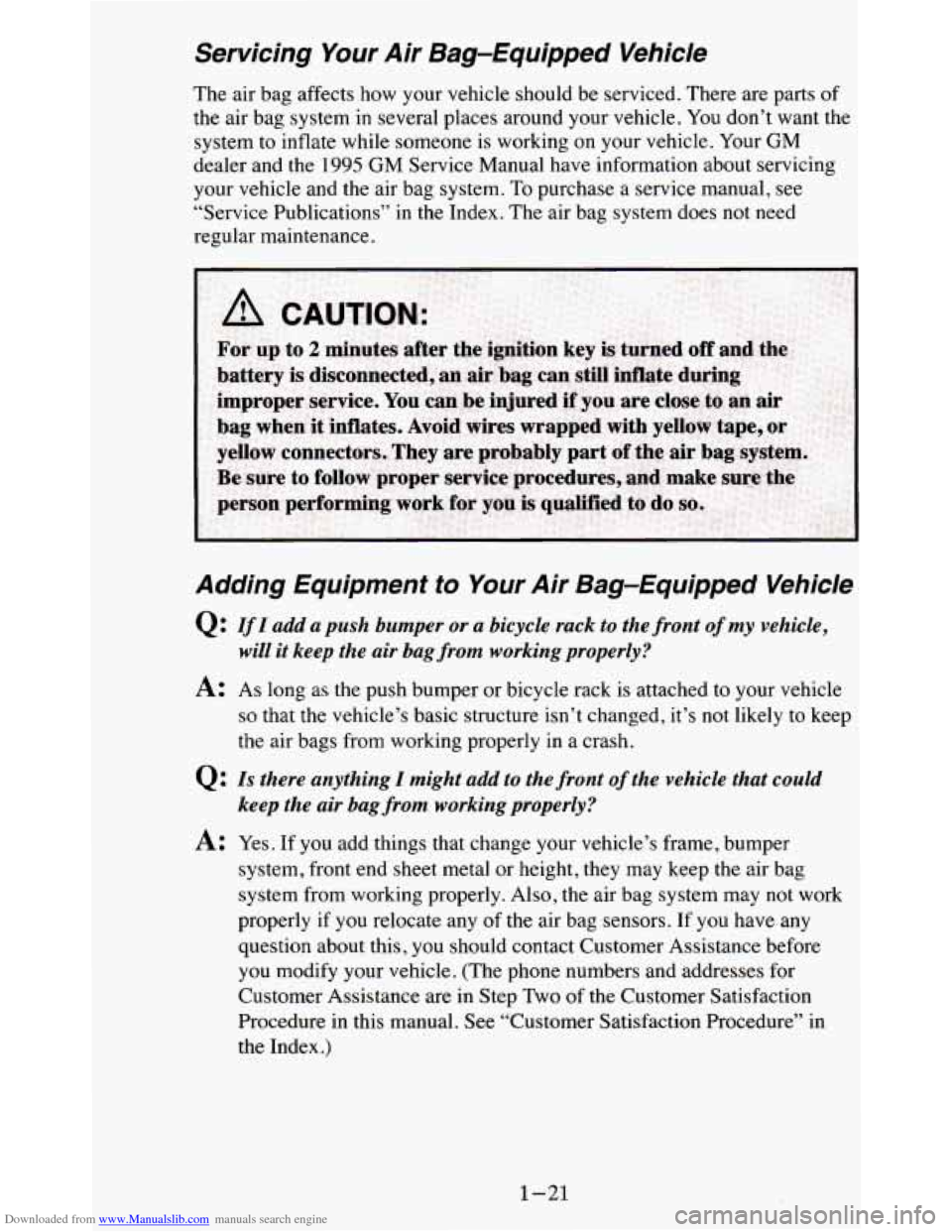
Downloaded from www.Manualslib.com manuals search engine Servicing Your Air Bag-Equipped Vehicle
The air bag affects how your vehicle should be serviced. There are parts of
the air bag system
in several places around your vehicle. You don’t want the
system to inflate
while someone is working on your vehicle. Your GM
dealer and the 1995 GM Service Manual have information about servicing
your vehicle and the air bag system.
To purchase a service manual, see
“Service Publications”
in the Index. The air bag system does not need
regular maintenance.
Adding Equipment to Your Air Bag-Equipped Vehicle
Q : If I add a push bumper or a bicycle rack to the front of my vehicle,
A: As long as the push bumper or bicycle rack is attached to your vehicle
will it keep the air bag from working properly?
so that the vehicle’s basic structure isn’t changed, it’s not likely to keep
the air bags from working properly
in a crash.
0: Is there anything I might add to the front of the vehicle that could
keep
the air bag from working properly?
A: Yes. If you add things that change your vehicle’s frame, bumper
system, front end sheet metal or height,
they may keep the air bag
system from working properly. Also, the air bag system may not work
properly if
you relocate any of the air bag sensors. If you have any
question about this, you should contact Customer Assistance before
you modify your vehicle. (The phone numbers and addresses for
Customer Assistance are
in Step Two of the Customer Satisfaction
Procedure in this manual. See “Customer Satisfaction Procedure” in
the Index
.)
1-21
Page 58 of 380
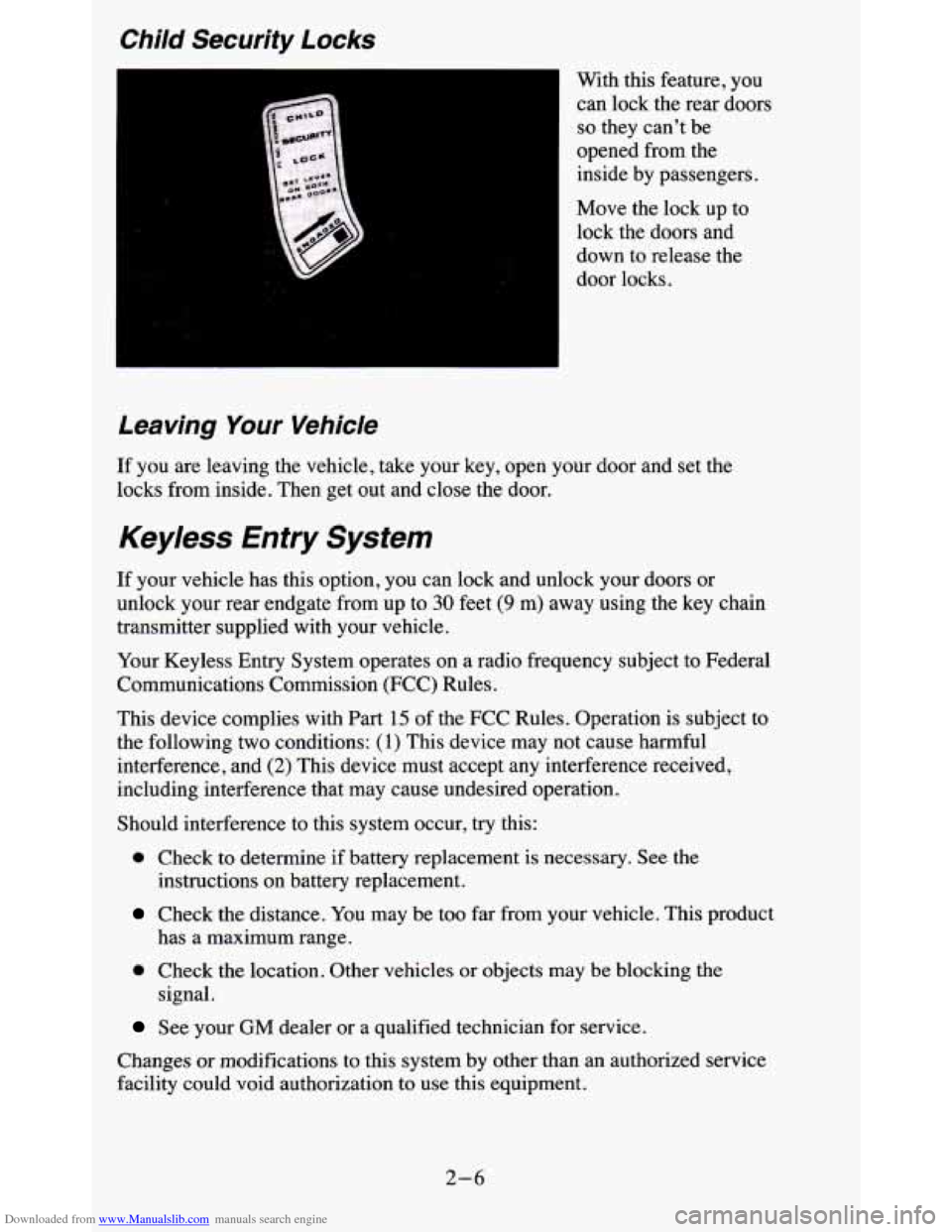
Downloaded from www.Manualslib.com manuals search engine Child Security Locks
7
With this feature, you
can lock the rear doors
so they can’t be
opened from the
inside by passengers.
Move the lock up to
lock the doors and
down to release the
door locks.
Leaving Your Vehicle
If you are leaving the vehicle, take your key, open your door and set th\
e
locks from inside. Then get out and close the door.
Keyless Entry System
If your vehicle has this option, you can lock and unlock your doors or
unlock your rear endgate from up to
30 feet (9 m) away using the key chain
transmitter supplied with your vehicle.
Your Keyless Entry System operates on a radio frequency subject to Federal
Communications Commission (FCC) Rules.
This device complies with Part
15 of the FCC Rules. Operation is subject to
the following
two conditions: (1) This device may not cause harmful
interference, and
(2) This device must accept any interference received,
including interference that may cause undesired operation.
Should interference
to this system occur, try this:
0 Check to determine if battery replacement is necessary. See the
Check the distance. You may be too far from your vehicle. This product
instructions on battery replacement.
has a maximum range.
0 Check the location. Other vehicles or objects may be blocking the
signal.
See your GM dealer or a qualified technician for service.
Changes
or modifications to this system by other than an authorized service
facility could void authorization to use this equipment.
2-6
Page 67 of 380
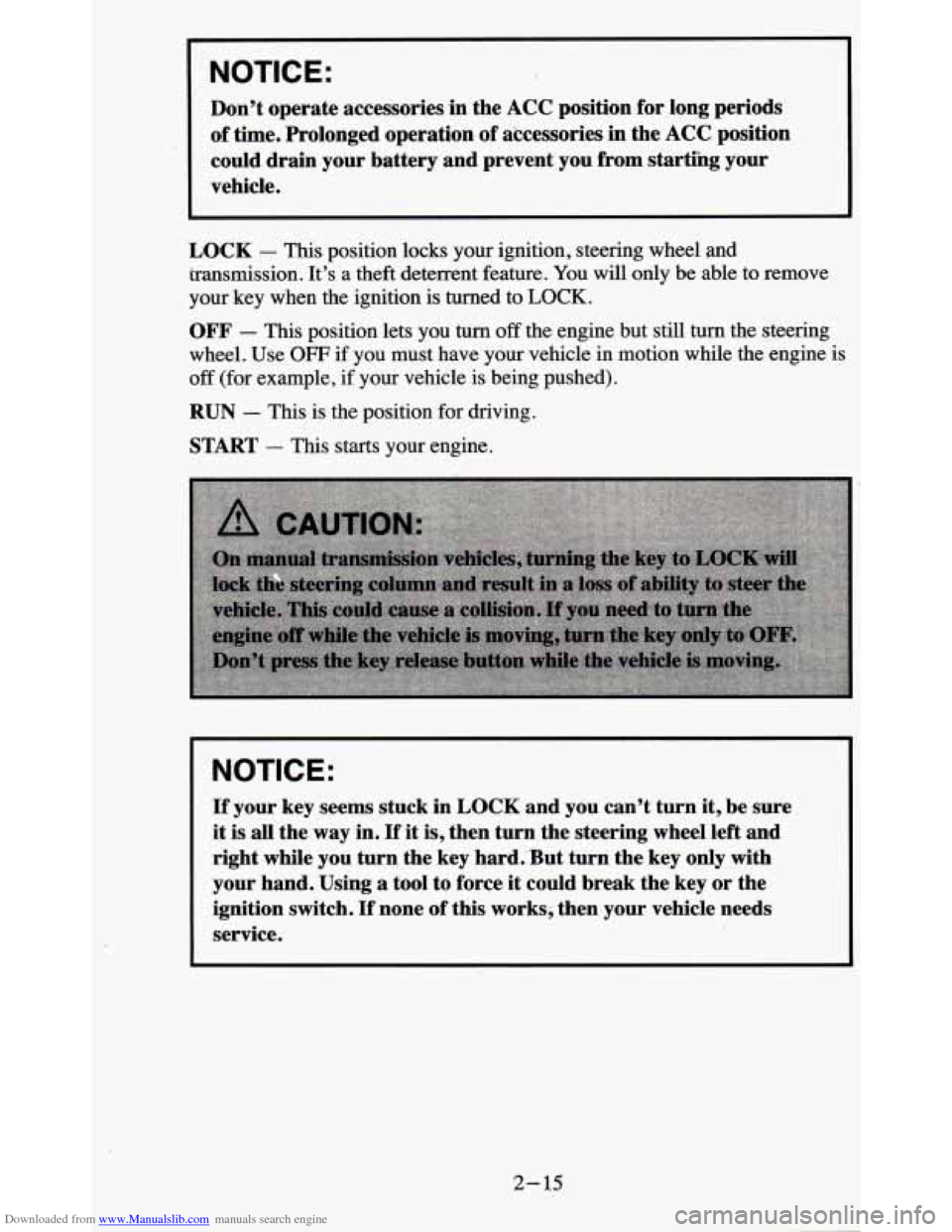
Downloaded from www.Manualslib.com manuals search engine I NOTICE:
Don’t operate accessories in the ACC position for long periods
of time. Prolonged operation
of accessories in the ACC position
could drain your battery and prevent you from startiing your
vehicle.
LOCK
- This position locks your ignition, steering wheel and
transmission. It’s a theft deterrent feature.
You will only be able to remove
your key when the ignition
is turned to LOCK.
OFF - This position lets you turn off the engine but still turn the steering
wheel. Use
OFF if you must have your vehicle in motion while the engine is
off (for example, if your vehicle is being pushed).
RUN - This is the position for driving.
START - This starts your engine.
NOTICE:
If your key seems stuck in LOCK and you can’t turn it, be sure
it is all the way in.
If it is, then turn the steering wheel left and
right while you turn the key hard.’But turn the key only with
your hand. Using a tool to force it could break the key or the
ignition switch.
If none of this works, then your vehicle needs
service.
2- I5
Page 84 of 380

Downloaded from www.Manualslib.com manuals search engine Electronic Transfer Case
If your four-wheel
drive vehicle has the
electronic transfer
case, the transfer case
switches are on the
right side of your
instrument panel
above
the radio
controls.
Use these switches to shift into and out
of four-wheel drive. You can choose
among three driving settings:
2HI - This setting is for driving in most street and highway situations.
Your front axle is not engaged in two-wheel drive.
4HI - This setting engages your front axle to help drive your vehicle.
Use 4HI when you need extra traction, such as on snowy or icy roads,
or in most off-road situations.
4LO - This setting also engages your front axle to give you extra
traction. You may never need 4LO. It sends the maximum power to all
four wheels. You might choose
4LO if you were driving off-road in
sand, mud, deep snow and climbing or descending steep hills.
Amber indicator lights
in the switches show you which setting you are in.
The indicator lights will come on briefly when you turn on the ignition and
one will stay on. If the lights do not come on,
you should take your vehicle
in for service. When shifting,
an indicator light will flash until the shift is
completed then remain solidly lit.
To shift from 2HI to 4HI - Press and release the 4HI switch. This can be
done at any speed, and the front axle will lock automatically.
To shift from 4HI to 2HI - Press and release the 2HI switch. This can be
done at any speed, and the front axle will unlock automatically.
To shift from 2H1, or 4HI to 4LO - The vehicle must be stopped or
moving less than
3 mph (4.8 km/h) with the transmission in NEUTRAL (N)
in vehicles equipped with an automatic transmission or the clutch pedal
depressed
in vehicles equipped with a manual transmission. The preferred
method for shifting into
4LO is to have your vehicle slowly moving 1 to 2
mph (1.6 to 3.2 km/h). Press and release the 4LO switch. You must wait for
the amber
4LO indicator light to stop flashing and go solid amber before
shifting your transmission into gear or releasing the clutch pedal.
2-32
Page 85 of 380

Downloaded from www.Manualslib.com manuals search engine If the 4LO switch is pressed when your vehicle is in gear and/or moving, tht
amber 4LO indicator light will flash for
30 seconds and not complete the
shift unless your vehicle is below
3 mph (4.8 ludh) and the transmission is
in NEUTRAL (N) or the clutch pedal depressed.
On automatic transmission equipped vehicles: If your transfer case does not
shift into 4L0, your transmission indicator switch may require adjustment.
With your transmission in NEUTRAL (N), press and release the 4LO
switch. While the amber 4LO indicator light is flashing, shift your
transmission into PARK
(P).
Wait until the 4LO indicator light goes solid amber before shifting your
transmission into gear. This will get you into 4L0, but you should take your
vehicle in for service
so normal operation can be restored.
To shift from 4LO to 4HI - Your vehicle must be stopped or moving less
than
3 mph (4.8 kdh) with the transmission in NEUTRAL (N) or the clutcl
pedal depressed. The preferred method for shifting out of 4LO is to have
your vehicle slowly moving
1 to 2 mph (1.6 to 3.2 kdh). Press and release
the 4HI switch.
You must wait for the 4HI indicator light to stop flashing
and
go solid amber before shifting your transmission into gear or releasing
the clutch pedal.
If the 4HI switch is pressed when your vehicle
is in gear and/or moving, the
4HI indicator light will flash for
30 seconds but not complete the shift
unless the vehicle is below
3 mph (4.8 kmh) and the transmission is in
NEUTRAL (N) or the clutch pedal depressed.
On automatic transmission equipped vehicles: If your transfer case does not
shift into 4H1, your transmission indicator switch may require adjustment.
With your transmission in NEUTRAL (N), press and release the 4HI switch
While the 4HI indicator light is flashing, shift your transmission into PARK
(P). Wait until the 4HI indicator light goes solid amber before shifting your
transmission into gear. This will get you into 4H1, but you should take your
vehicle in for service
so normal operation can be restored.
2-33